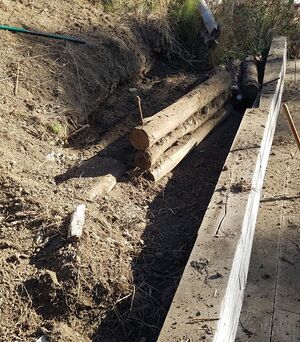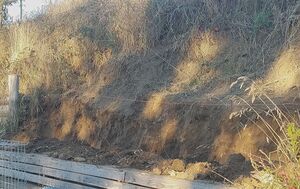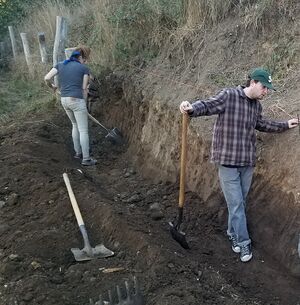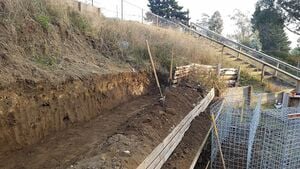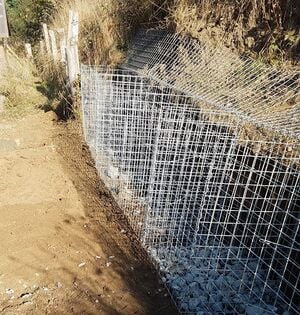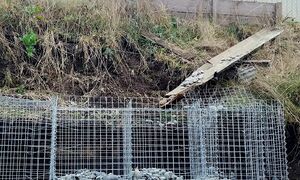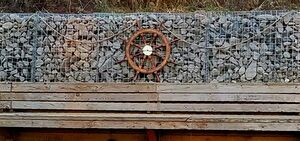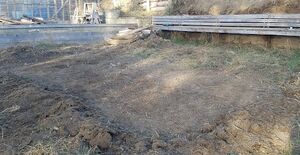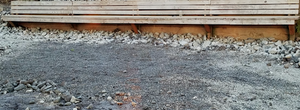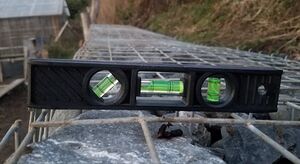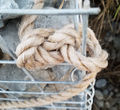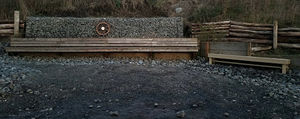
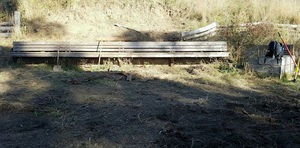
This project was created to preserve the outdoor learning area at Six Rivers Charter School in Arcata, California. A retaining wall, extra bench, improved footing, and pirate-themed design were added to the square to allow improved educational usage. The project was designed to both maintain the existing garden space as well as further its availability as an outdoor learning environment.
Background[edit | edit source]
Representatives from Six Rivers Charter School wished to improve the existing garden area on campus, which had been becoming rundown. This need was met by a group from the Fall 2018 Intro to Design engineering class at Cal Poly Humboldt, under instructor Lonny Grafman. The team took the open-ended task and narrowed its focus to improving the educational use of the existing space used for teaching, with the endgoal being to allow any class to utilize the space for outdoor lectures and learning.
Problem statement and criteria[edit | edit source]
The garden area at Six Rivers Charter School needed to be generally improved, and the group needed to decide how to best help achieve that goal. The final decision was centered around preventing a landslide into the garden area, and took into account the following criteria. Each criteria was assigned a weight in respect to a fixed set of constraints.
| Criteria | Constraint | Weight |
|---|---|---|
| Educational Value | Must have an educational aspect | 8 |
| Maintainability | Must require two days of maintenance a week or less | 8 |
| Time | Must take ten weeks or less to complete | 7 |
| Longevity | Must remain functional for at least a year | 6 |
| Sustainability | Must include at least three sustainable methods | 6 |
| Cost | Must be less than or equal to $325 in expenses | 5 |
Description of final project[edit | edit source]
The final design involved replacing a retaining wall, leveling the ground, adding pea gravel and an additional bench, and applying a pirate theme to the retaining wall area. The retaining wall replaced a pre-existing rotted wooden retaining wall, and consists of 26 ft of gabion cages on the hill behind the pre-existing student bench used for outdoor classes. The ground in the square was leveled and covered in pea gravel to allow classes to be held outside after rain. An additional bench length was added next to the existing bench to allow a full class to sit for outdoor lectures, enabling more than just agricultural classes to utilize the space. Finally, manilla rope was draped across the gabion cages, and a 3 ft ship wheel was added as a center piece to incorporate the school's pirate theme into the square.
-
The final project overall.
-
Additional redwood bench.
-
Leveled ground with pea gravel.
-
Gabion cage retaining wall displaying nautical elements.
Prototyping - Early Designs[edit | edit source]
Due to the long-term use and public knowledge of gabion cages, benches, and leveling, the group used design ideas in lieu of prototyping to decide upon a final design. The first ideas included a variety of specific ideas that could improve different aspects of the garden area in general. Correspondence with the charter school representatives led to a narrowed focus pertaining to the retaining wall. After consulting an architect at Cal Poly Humboldt, the final design shifted from a wooden to gabion retaining wall, but retained the nautical-themed characteristics.
-
Redesign stylized to resemble the side of a pirate ship, centerpiece removed.
-
Retaining wall cross-section with plank/stanchion format.
-
Gabion wall design with nautical elements
-
Top-side view of the autocad design.
Costs[edit | edit source]
| Item | Quantity | Project Cost /yard | Retail Cost /yard | Project Cost | Retail Cost |
|---|---|---|---|---|---|
| Gabion Cages
1 (8ft x 3ft x 4ft) 3 (6ft x 3ft x 4ft) |
18.5 | n/a | $35.00 | Donated | $650.00 |
| Gabion Cage Rocks | 8.0 | n/a | $35.00 | Donated | $277.76 |
| Pea Gravel | 3.5 | n/a | $50.00 | Donated | $175.00 |
| 1 in Manila Rope | 10 | $1.77 | $1.77 | $19.20 | $19.20 |
| 3 ft Nautical Wheel | 1; 3 ft diameter | n/a | n/a | $49.69 | $49.69 |
| Lumber | 24 yd | n/a | $9.99 | Donated | $239.76 |
| Paint Sealant | 1 can | n/a | $24.99 | Donated | $24.99 |
| Plotting Supplies | Cordage and Stakes | n/a | n/a | $11.00 | $11.00 |
| Total Cost | $79.89 | $1447.40 | |||
How to build[edit | edit source]
Gabion Cages
The cages were assembled using Hilfiker's manual for Gabion wall building, which can be found here: http://www.hilfiker.com/awg.html
Maintenance[edit | edit source]
The maintenance for this project is relatively low. Gabion walls are composed of galvanized steel and last for 25 years. In drier climates the bench and flooring would last longer but with the heavy rainfall in Arcata the bench will most likely need to be replaced after 15 years, and the pea gravel may need to be supplemented every 5 years.
Maintenance Schedule[edit | edit source]
- Weekly
- Weeding
- Monthly
- Light inspection of gabion cages for wear and breakage
- Yearly
- In depth inspection of gabion cages
- Minor re-leveling of square ground
- Inspect manila rope
- Every 5 years
- Re-leveling of square ground
- Replace gravel
- Inspect and possibly replace manila rope
- Every 25 years
- Replace gabion cages
Instructions[edit | edit source]
Troubleshooting[edit | edit source]
Basic troubleshooting guidance
| Problem | Suggestion |
|---|---|
| Rope fell down | If a corner fell down, find where rope was attached and re-tie. The current roped is tied with a slip knot. If one of the center loops fell down, use the spare hog rings left in the shed to reattach the rope in desired position. |
| Metal attachments overly rusted or missing | Remember to use leftover replacement pieces. |
| Wheel needs to be replaced or taken down | Use bolt cutters to remove the two locks on the current wheel. |
-
The current slip tie knot.
-
The box of spare hog rings.
Suggestions for future changes[edit | edit source]
Recommended changes for the future would be the addition of more plant life in the areas bordering the wall and benches. Additionally portable seating could be added to accommodate larger class sizes for lectures in this area. Lastly, it would be beneficial to replace all of the remaining eucalyptus retaining walls with gabion cages, as eucalyptus is sure to fail in the future in the climate of this region.






